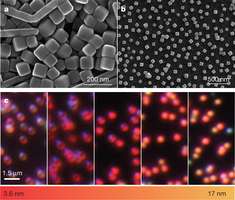December 6, 2012 report
Research team discovers new way to make near perfect light absorber

(Phys.org)—An international research team led by David Smith of Duke University has created a new type of light absorbing material that is far cheaper to make than conventional methods. They describe their polymer coated gold base material dusted with tiny cubes of silver in their paper published in the journal Nature.
The ability to absorb light is a useful property in many photonic applications – being able to do so completely is even more valued. Metamaterials (those not found in nature) that do so are currently made using lithography, which is both costly and time consuming, limiting the types of applications that they can be used for. With the development of a new metamaterial by the research team, that may change.
To make the new material the researchers placed a very thin piece of gold on top of a piece of flat glass then dipped it into a polymer solution to create a polymer layer over the gold just a few nanometers thick. Next, they cut a piece of silver into very small cubes, each just 74 nanometers wide and tossed them randomly onto the polymer coated gold. And that was all it took.
The setup works because when light with a certain wavelength hits one of the cubes, its electrons get excited and start to oscillate with the electrons in the gold beneath. The researchers believe the resulting Plasmon resonance between the two metals causes light to become trapped in the polymer material. Because of that, the thickness of the polymer is critical in defining which wavelength of light will be captured. By creating a bass with an array of platforms with different thicknesses, it becomes possible to absorb all the light that arrives at a single device.
In testing the new material, the team says it works just as well as materials made from etching, but costs far less to produce. Because of that, they add, it becomes possible to build bigger and a more diverse group of photonic devices. One hitch in the system remains – how to manufacture the silver cubes to be nearly perfectly cut and all of the same exact size.
Next up for the team is looking at other materials that might be used instead of the polymer for applications that require heat resistance.
More information: Controlled-reflectance surfaces with film-coupled colloidal nanoantennas, Nature, 492, 86–89 (06 December 2012) doi:10.1038/nature11615
Abstract
Efficient and tunable absorption is essential for a variety of applications, such as designing controlled-emissivity surfaces for thermophotovoltaic devices, tailoring an infrared spectrum for controlled thermal dissipation and producing detector elements for imaging. Metamaterials based on metallic elements are particularly efficient as absorbing media, because both the electrical and the magnetic properties of a metamaterial can be tuned by structured design4. So far, metamaterial absorbers in the infrared or visible range have been fabricated using lithographically patterned metallic structures, making them inherently difficult to produce over large areas and hence reducing their applicability. Here we demonstrate a simple method to create a metamaterial absorber by randomly adsorbing chemically synthesized silver nanocubes onto a nanoscale-thick polymer spacer layer on a gold film, making no effort to control the spatial arrangement of the cubes on the film. We show that the film-coupled nanocubes provide a reflectance spectrum that can be tailored by varying the geometry (the size of the cubes and/or the thickness of the spacer). Each nanocube is the optical analogue of a grounded patch antenna, with a nearly identical local field structure that is modified by the plasmonic response of the metal's dielectric function, and with an anomalously large absorption efficiency that can be partly attributed to an interferometric effect. The absorptivity of large surface areas can be controlled using this method, at scales out of reach of lithographic approaches (such as electron-beam lithography) that are otherwise required to manipulate matter on the nanoscale.
Journal information: Nature
© 2012 Phys.org



















